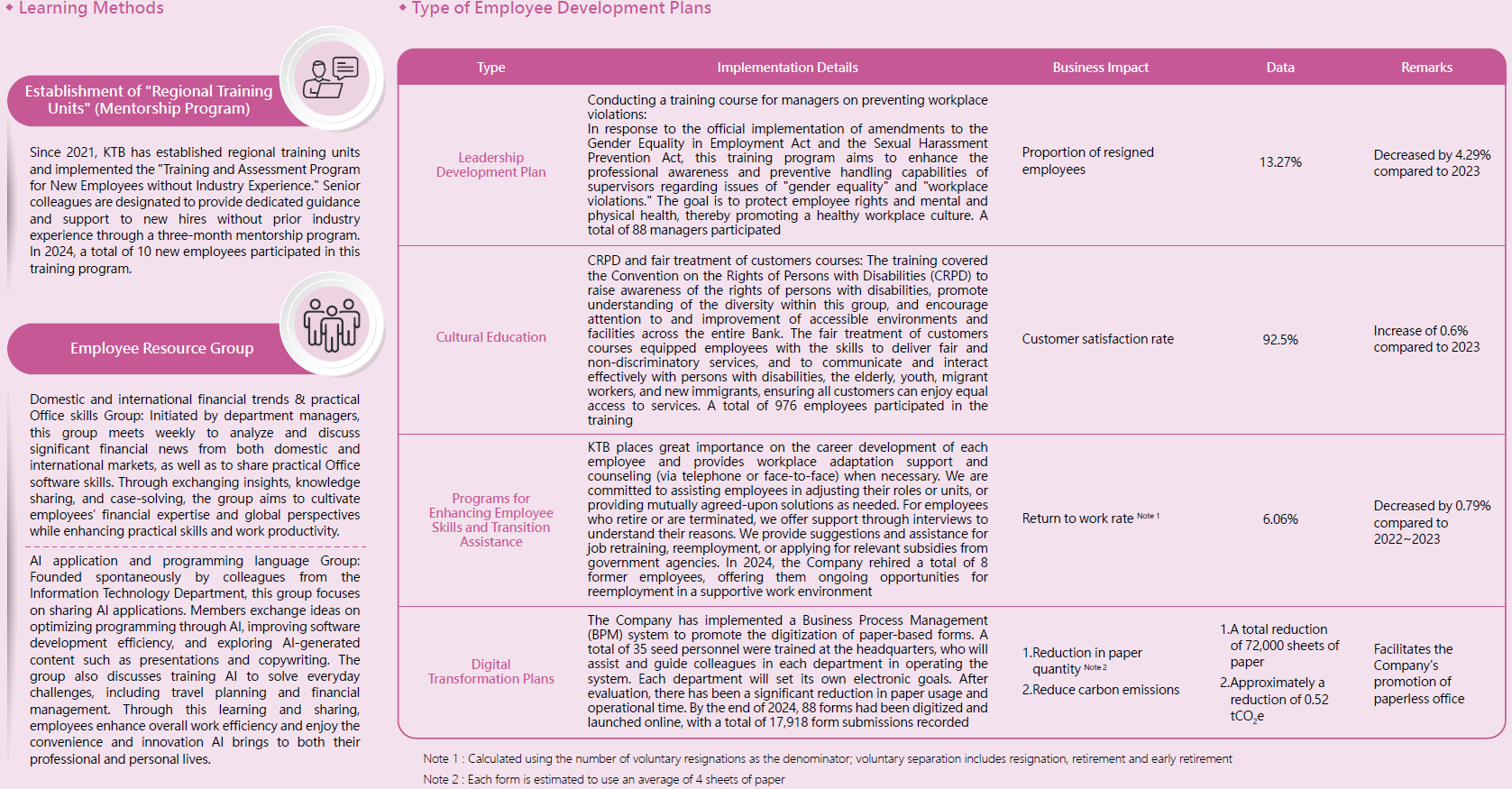Comprehensive Training System
In 2024, KTB held or participated in 956 internal or external education training classes (including 386 physical classes, 515 online classes and 55 financial management classes) with 80,740 participants. Every employee took part in 80 education training courses on average, with a total of 86.2 training hours. For details on education training, please refer to Appendix 8.4 Human Resource Management Indicators.
KTB provides a comprehensive training system that includes onboarding programs for new employees, general education training, tiered training for managerial staff, specialized professional and technical training, and other programs (including internal on-the-job training hosted by various departments, legal compliance courses, ESG and sustainable finance, and occupational safety and health training). Training programs are arranged or encouraged based on employees’ tenure, job roles, and professional competencies. These training initiatives aim to enhance the knowledge and skills required for each position, improve organizational efficiency, strengthen employees’ sense of belonging to the KTB, and support the development of individual career paths.
Incentives and Subsidies for Continuing Training and Certifications
Besides encouraging employees to participate in internal and external education training, KTB also designs a system to provide its employees with career growth opportunities and resources. KTB has formulated the "Major Licenses/Certificates Subsidy Scheme" based on the list of required certificates for each position and duty. For employees who obtain international certificates, such as CFA, FRM, AFMA, PMP, they may apply for subsidies for the application fee, and receive an additional monthly professional allowance. For details on the certificates held by KTB employees in 2024, please refer to "Page 57-58 of King's Town Bank Co., Ltd. 2024 Annual report"


Employee Development Plans
The "Employee Development Plans" not only enhance employees' skills, knowledge, and professional capabilities, but also serve as a cornerstone for the Company’s stable growth. In response to the rapidly evolving market environment and digital product landscape, KTB is committed to effectively developing and nurturing employee competencies. The Company views the modes of employee learning and types of development plans as key priorities. These plans aim to improve job performance, strengthen team competitiveness and innovation, and offer personalized learning and development opportunities. They are designed to support employees in their career growth, help them achieve their goals, and ultimately realize their full potential.

Expanding Career Experience through Job Rotation
The cultivation of talents relies not only on education training and continuing training but also on a systematic job rotation mechanism. Job rotation provides the employees a chance to expand their experience beyond their duties, enhance their abilities, and unlock their potential. From the organization's perspective, job rotation brings stimulation to internal revitalization and enhances the flexibility and breadth of manpower. At the same time, job rotation also reduces job burnout from long-term repetitive work, so as to strengthen the internal operational safety control.
We have formulated the "Regulations Governing Job Rotation" to mitigate the disadvantages and strengthen the advantages through systemization and scheduled rotation. The job rotation mechanism consists of job rotation training and internal recruitment. The former is a planned training based on the internal needs of the organization; while the latter is based on the employees' willingness to change their career path. Content of job rotation includes:
√ Job rotation within the unit: Become an all-rounded financial expert through gaining experience in different areas of the business.
√ Job rotation between the unit: Learn to work with different colleagues and enhance the ability to collaborate.
√ Interdepartmental rotation or rotation between headquarters and branches: Cultivate the ability of strategic planning, strategy execution, and receiving customers, and improve the communication between departments or between headquarters and branches.
In 2024, the number of public recruitment was 129 and there were 108 positions transferred through job rotation training, and only 1 position through internal recruitment. The filling rate of internal employees for vacancies was up to 45.80%. For relevant data, please refer to Appendix 8.4 Human Resource Management Indicators.
In order to protect the rights and interests of the employees, when there are changes in labor contracts due to KTB's business or employee career planning, they shall be announced in accordance with the following regulations, and KTB shall prepare the employees for job handover and their new work environment, so as to minimize the job handover time and the occurrence of operational risks.
√ Where an employee has worked continuously for more than 3 months but less than one year, the notice shall be given 10 days in advance.
√ Where an employee has worked continuously for more than 1 year but less than 3 years, the notice shall be given 20 days in advance.
√ Where an employee has worked continuously for more than 3 years, the notice shall be given 30 days in advance.
Diverse Performance Evaluation
When formulating corporate strategies, KTB first establishes overall goals and strategic directions for the entire organization. Based on these overarching objectives, each department sets corresponding specific goals and strategies. This approach ensures the effective implementation of the corporate strategy across the entire Bank. Building upon this foundation, the Company sets individual Key Performance Indicators (KPIs) to serve as performance assessment tools for each employee. This alignment facilitates the connection between personal and team objectives, jointly driving the Company's development. In 2024, 98.61% of eligible employees underwent performance evaluations. The assessment targets included all employees actively employed as of December 1, 2024 (including probationary staff and interns), excluding part-time workers, employees who joined on that date, and those who had submitted resignation or retirement notices effective before the end of December.
